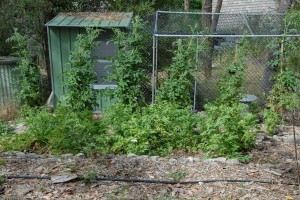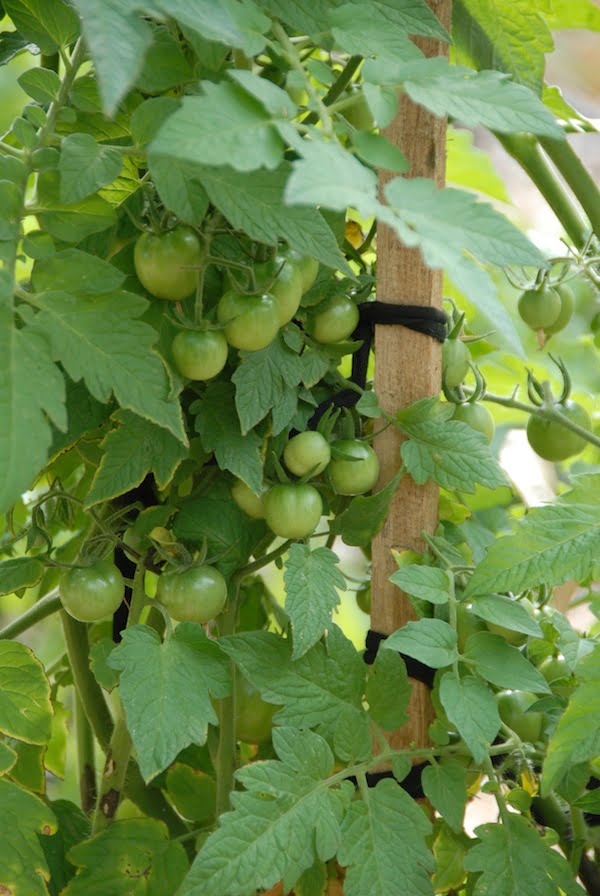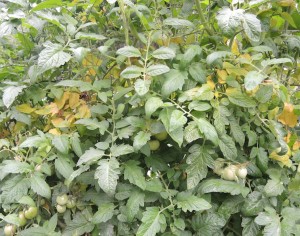A highlight of my first northern hemisphere trip was… tomatoes. Italian tomatoes. Pathetic, right? Just… tomatoes. Yep, a food and gardening tragic… but – oh! – those Italian tomatoes!
 Forget the hard, watery, sour excuses in Aussie shops – even the ones labelled vine-ripened don’t taste that way (how is that done?). Tomatoes in Italy were so ripe when you bought them that they lasted only two days before liquefying in the fruit bowl – but that didn’t matter because you could buy every variety, every day, from every corner stall.
Forget the hard, watery, sour excuses in Aussie shops – even the ones labelled vine-ripened don’t taste that way (how is that done?). Tomatoes in Italy were so ripe when you bought them that they lasted only two days before liquefying in the fruit bowl – but that didn’t matter because you could buy every variety, every day, from every corner stall.

Just grab a few ingredients…
 for divine pasta.
for divine pasta.

Yum tomato pasta
Briefly warm tomatoes with garlic, chilli and a little mince or anchovies in a glug of olive oil in a pan, then toss the lot through pasta with fresh basil, white wine, salt and pepper – done! You’d have to cook the crap out of store-bought Aussie tomatoes to get the same depth of flavour!
 So of course a high priority – in fact, the highest priority– in my new vegie patch was tomatoes. Even though the soil had not yet been properly prepared, and the spot by the chook yard was too shady……
So of course a high priority – in fact, the highest priority– in my new vegie patch was tomatoes. Even though the soil had not yet been properly prepared, and the spot by the chook yard was too shady……
….in 2011, I planted half a dozen cherry tomatoes for a modest harvest

A modest harvest of tomatoes
…before they succumbed to blight in the poor conditions.

Tomatoes suffering from blight in shady conditions
A bigger crop was planted in 2012, including black, yellow and red cherry tomatoes, Grosse Lisse and a few others:
 Better (albeit still first year) soil preparation produced a larger harvest.
Better (albeit still first year) soil preparation produced a larger harvest.

I had a larger harvest in 2012 with different varieties and better soil preparation

9m of new, trellised tomato plantings
In 2013, I aimed to grow a year’s supply of tomatoes – about nine metres of trellis in a new bed, plus another ten individual plants scattered elsewhere, in many varieties: Roma, Tommy Toe, Yellow Tommy Toe, Sweet Bite, Apollo, Red Russian, Grafted Mighty Red, Burnley Bounty, Tigerella, My Ugly, Burke’s Italian, Green Zebra, Tom Boy, Tiny Tim. This time, I weighed the crop to identify which varieties were the best performers and best tasters. But this wasn’t as straightforward as it sounds.
I harvested 70.9 kilos of tomatoes. The graph shows cumulative harvest per variety but, where multiples of a variety were planted, I divided by the number of plants to get crop per plant.

2013 Tomato Harvest — cumulative harvest per variety
First: yes, good old Burnley Bounty, an Australian tomato developed for (relatively) cold conditions, did the best (just over 10 kg from one plant). It was reasonably disease-resistant, and the mid-size fruit, 50-75% larger than a golf ball, made harvesting and preparation less time-consuming than for cherry tomatoes. An early-bearing variety, it also finished late.

Green Zebra tomato
The single grafted Mighty Red did well (8.72 kg) but nowhere near as well as expected, given it received the same soil preparation in the same part of the garden. Worse, rather than ripening, the fruit spoiled on the vine at the end of the season. Apollo was pretty good too, followed by Green Zebra, which impressed me with its vigour, health and fruit that continued to ripen very late. Grosse Lisse performed acceptably too. Last of the reasonable bearers was Black Russian, which was so delicious I’d grow even if it had half the fruit. The Sweet Bite plants were spindly and weak, were hard hit by blight, and the fruit split easily.

Sweet Bite tomatoes
So what of the others? Tigerella, touted to be one of the heaviest croppers (up to 15 kg), producing just 2.4 kg? Why did Tommy Toe Yellow produce very little, but still almost double that of Tommy Toe Red? What happened to the four Romas, Burke’s Italian, Sweet Bite, Mr Ugly, Tiny Tim and Tom Boy, all with negligible crops? Are they all useless in my garden?
Well, no. Lies, damned lies and statistics. Read on for clues.
1. Season and planting time.
Look at those harvest dates: February! That’s very late indeed to be harvesting the first tomatoes: cherry varieties are usually ready long before Christmas. So the season in the Hills was – by all accounts from numerous customers I asked at the Crafers Garden Centre – atrocious. Many gardeners picked no tomatoes at all, or a tiny fraction of their usual harvest. Even though I had potted seedlings into black plastic pots to grow on, and only transplanted them into the ground at the end of October, the plants sulked through continuing cold, damp conditions, and were finally battered by a hailstorm at the end of November.

Symptoms of tomato russet mite perhaps?
I have only ever used (organic) sulphur and copper fungicides on my tomatoes, but the Early Blight was winning, and I was pretty certain I’d lose every plant, so I sprayed a single time with Mancozeb, which saved them. After that I continued dusting with sulphur, which also controlled a small area of what I think might have been tomato russet mite. The leaves affected by early blight shrivelled, but subsequent growth in warmer weather was fine.

Tigerella tomato
Planting at the right time is essential. Tigerella, Mr Ugly and Burke’s Italian weren’t planted until early December, which casts the Tigerella harvest in a completely new light ie, not bad at all! I’m giving Burke’s Italian another chance this year too (which should be a much better season as soil temperatures are tracking two weeks ahead of normal).
Still, with the exception of Burnley Bounty and Sweet Bite, almost all the varieties established on the trellis had a band of fruit at the bottom of the bushes, followed by a band without fruit during the cold snap, followed by fruit again at the top of the bushes. So regardless of what seed catalogues say about cropping, those figures are meaningless in a bad season: in other words, season will have more impact on your harvest than variety per se (unless you can exactly match cultivar requirements to specific conditions).
2. Microclimate and aspect: I was happy with 70 kg, because the season was poor, plus my southerly aspect warms late, and trees to the north exacerbate this. Full sun position? Yeah right, who has that luxury in forested Crafers, Stirling, Aldgate and Bridgewater? Once the sun arcs higher in the late spring sky, our tomatoes take off but, until then, things are slow. Many Hills gardeners grow tomatoes in dappled shade – sometimes exacerbated by root competition from stringy-bark eucalypts – or in morning sun only, or afternoon sun only. This affects yields of all varieties, but you can still get a modest harvest with excellent soil preparation. If you live locally, I’d love to hear which tomatoes do best in your garden’s microclimate (Legef, Super Roma, Principe Borghese and Gabriella have been recommended to me).
3. Soil preparation: Preparing (soil improvement, irrigation) all the garden beds in the new area at once wasn’t feasible in either time or dollars. So of the five beds, each of my tomato crops in the new area have gone in as the first crop in that particular bed (excluding the first season where I grew tomatoes in the berry area; I’m now on the third bed). The beds were prepared with manure, rock dust, Go-Go- juice, Seasol, and compost… but each time for the tomatoes it’s still the first year of soil improvement in that particular bed, which won’t reach peak productivity for another three or four years.
Because I mix vegetable plantings in a sort-of-permaculture system, I don’t bother with crop rotation, except for the tomato family. Once the soil is fully improved, I probably won’t bother rotating them but, at the moment, the plants are more susceptible to disease because the soil still has such a long way to go.

Soft growth on tomatoes is more susceptible to fungal attack
For the first time last year I tried a Manutec tomato tablet (one tablet, not the two recommended per plant). It’s very possible that this concentrated fertiliser exacerbated the disease situation by creating lush, soft growth more susceptible to fungal attack, and this season I’ve added only a sprinkle of sulphate of potash to the compost, manure and rock dust.
So what’s with those Romas, the Tiny Tim and the Tommy Toes? Are they crap varieties for my garden? Again, the graph is misleading. I planted these varieties into areas of the garden that had no soil improvement at all… what a difference! More than variety, soil quality dictated harvest, so prepare it well and any variety will probably thrive too. In fact, Yellow Tommy Toe cropped amazingly well, considering! Only Tom Boy, planted right beside Grosse Lisse, Black Russian and the other good performers in the same soil in the same bed, has no excuse for its poor performance. Still, there are probably variables I haven’t considered, so I’ll try it again in a year or two to see if this was an aberration.
4. The taste test: All those taste tests comparing numerous cultivars are fine but, in my opinion, two things trump variety per se. First –
the worst home-grown tomato variety will still taste much better than any store-bought one
Second, for me at least, ripeness has more effect on taste than variety, so a fully vine-ripened tomato of any variety tastes better than a less ripe tomato of any other variety. So although I’m still experimenting with varieties old and new (this season, new ones include Black Krim, Rouge de Marmande, Super Roma, Oxheart, Mortgage Lifter, Honey Drop, Corn Boy, Tumbling Tiger, Principe Borghese as well as repeats of Black Russian, Green Zebra, Mighty Red, Tommy Toe and Tigerella), I’m confident that they’ll all taste good!

Part of my 70kg tomato harvest

Home-made passata
What did I do with 70 kg of tomatoes? Gave away lots, of course, but also cooked down much of it into passata (reduce by 50 per cent, then freeze in ziplock bags). The cherry tomatoes were tossed with chilli, garlic, seasoning and olive oil, roasted till syrupy, and frozen in ziplock bags.
My favourite tomato salsa is indescribably good only with home-grown, fully vine-ripened very ripe tomatoes (don’t bother with anything else). Chop tomatoes roughly and put in a bowl with 20-30 per cent by volume of good olive oil. Stir through salt, freshly ground pepper, crushed garlic, torn basil leaves and chopped chilli to taste. Cover with cling wrap and leave to macerate at room temperature for 2-3 hours. Use as a side salad with chicken or steak, on bruschetta with feta or shaved parmesan, or tossed through pasta. Drizzle torn sourdough bread in olive oil and season, roast bread till crisp, then toss through tomatoes for panzanella. Yum! Can’t wait for this season’s harvest!

